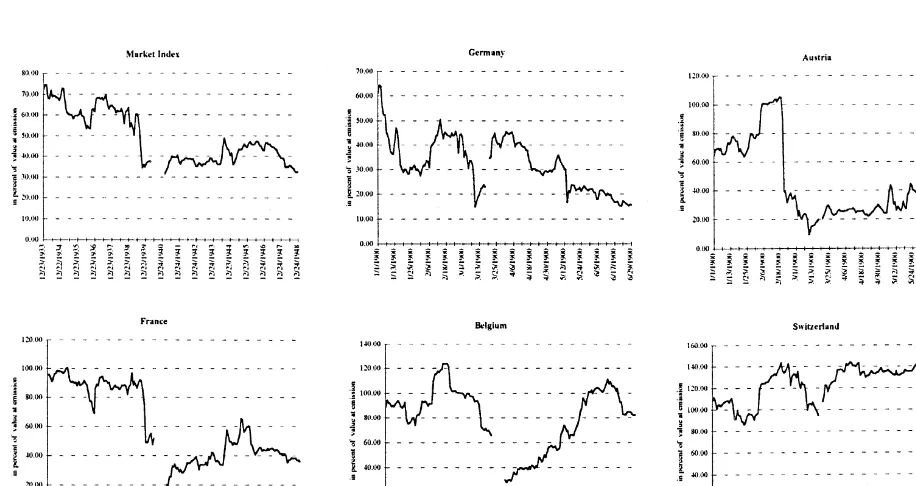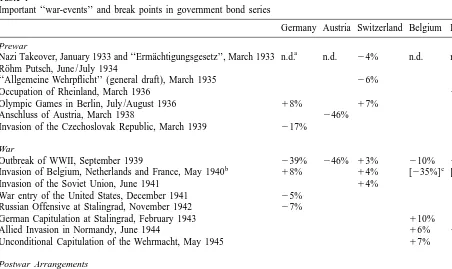www.elsevier.com / locate / econbase
World War II as reflected on capital markets
*
Bruno S. Frey , Marcel Kucher
University of Zurich, Institute for Empirical Economic Research, Blumlisalpstrasse 10, CH-8006 Zurich, Switzerland
Received 6 July 1999; accepted 16 December 1999
Abstract
Historical events are reflected in asset prices. We analyze government bond prices of five European countries traded on the Swiss bourse during WWII. Apart from the official outbreak of WWII, loss and gain of national sovereignty influenced the capital market. 2000 Elsevier Science S.A. All rights reserved.
Keywords: Financial markets; Economic history; WWII; Europe; Cliometrics
JEL classification: G1; N24
1. Introduction
This paper econometrically analyzes changes in financial values as reflections of events in and before World War II. The change in the values of national government bonds issued in Swiss Francs and traded on the Swiss bourse is examined for the period 1933–1946. The Swiss government, for reasons of neutrality, refrained from interfering in the bond market (except for the 2 months following the German attack against the West in May and June 1940, when the Swiss bourse was closed). The government bond market in Switzerland consisted mainly of five countries: Germany, the main aggressor; Austria, a country integrated into the Third Reich; France, the major and traditional enemy of Germany in the West; Belgium and Switzerland, two neutral countries, the first of which was drawn into the war, while the latter was spared direct involvement.
2. Data and estimation procedure
The use of capital market data has three particular advantages over other sources of data:
*Corresponding author. Tel.: 141-1-634-3731; fax: 141-1-634-4907.
E-mail address: [email protected] (B.S. Frey).
1. They solely reflect the situation obtaining at a given point of time. Future developments and insights cannot enter the data at a later date. Capital market data capture the expectations about how a particular war event changes the likelihood of a country servicing and repaying its international debt.
2. Actors on financial markets have strong incentives to carefully evaluate the prevailing situation, as well as any likely future developments, because errors directly affect them in monetary terms. This distinguishes capital market data from data such as surveys or questionnaires.
3. Financial markets usually exhibit a high predictive power, due to so-called marginal traders.
The countries that borrowed the most on the Swiss capital market during the time-span between the two world wars were France and Germany, followed by Belgium and Austria. Converted into today’s Swiss Francs, the value at emission of the 31 German government bonds equalled roughly 3 billion Swiss Francs. France’s government debt in Switzerland equalled 3.6 billion Swiss Francs, and Belgium and Austria borrowed one billion and 590 million Swiss Francs respectively. All the bonds were issued and traded in Swiss Francs. A weighted index of the values of all government bonds issued in Switzerland is analyzed for each of these countries. Due to their large number, the analysis is restricted to the 12 biggest Swiss government bonds.
The data stem from the ‘Monatsberichte der Schweizerischen Nationalbank’, January 1929– January 1949.
The econometric method applied searches the data for structural breaks in the series of government bond prices. The procedure consists in estimating conditional random walks within 48 month-windows, which are then tested for differences in the means of the bond prices between the time windows.
To identify all possible dates for structural breaks, a four-step procedure based on Banerjee et al. (1992) and Perron (1989) is applied. Steps one to three determine which periods to look at. In step four, we test for statistically significant structural breaks within each of the windows isolated. A series of the following equations is estimated:
]]
ln pt5b01b1ln pt211b2ln pt211gsDst1et (1)
with s56, . . . , 42, p stands for the index-value of all government bonds of the country consideredt
]
on date t, p is the index of all government bonds traded in Zurich (a measure of market performance),t
Dst51 if date t is on or after date s and zero otherwise,etis a white noise error term. The parametergs
measures a change in the conditional mean (i.e. a shift in the mean price index ceteris paribus) occurring on date s. gs is the percentage change in the conditional mean. Eq. (1) is estimated repeatedly, each time moving s by 1 month. For each resulting equation, it is tested whether gs is different from zero using a conventional F-test. The date associated with the highest F-statistic is then designated as the date where the most important mean shift took place within each window. Similar methods were used by Sobel (1998) or Willard et al. (1996), to identify breaks in the series of exchange rates.
3. Estimation results
3.1. The raw data
Fig. 1 shows a strong downturn in the market index before the outbreak of WWII. During the war, the index remained stable at around 40 percent of par. One interesting feature is the peak in 1944, just about the time when the allied forces invaded Normandy.
The 31 German government bonds traded in Switzerland experienced a strong reduction in value over the entire period. The partial recovery in 1937 and 1938 may be due to the Nazi government’s gain in financial respectability in 1937–1938 (mainly because of the expansion of national income and the fall in unemployment).
But Hitler’s aggressive foreign policy and increasing isolation led to a drastic fall in German bond prices towards the end of 1939, when WWII broke out. The value of German government bonds rose again after the successful Blitzkrieg at the beginning of 1940, but from the second half of 1941 on, they experienced a permanent fall.
The monthly index of the nine Austrian government bonds traded in Switzerland shows a marked increase in value between 1933 and 1937. There was a huge drop with the Anschluss (annexation) of Germany in 1938, and the index remained much depressed thereafter.
forces, and the French capitulation (22 June 1940). After trading was resumed at the Swiss bourse, the French bonds experienced a continuous increase in value until the end of 1945.
The values of Belgian government bonds traded in Switzerland exhibit marked variations. A marked increase from 1934 to 1937 is followed by an even stronger fall, dropping to a value of about 30% in 1940. Throughout the remainder of World War II, the bond values show a continuous recovery, ending in 1947.
The Swiss government bonds display an overall long-term rise of about 30% over the 20-year period 1928–1948. The Swiss government bonds dropped in the years before the ‘official’ outbreak of the war, but after the successful ‘Blitzkrieg’ they regained and even surpassed the pre-war level.
3.2. Identification of breaks
Table 1 lists 16 important historical events and compares them to the econometrically estimated (statistically significant) breaks in the government bond values.
Only one event, the ‘official’ outbreak of the Second World War, produces statistically significant
Table 1
Important ‘‘war-events’’ and break points in government bond series
Germany Austria Switzerland Belgium France
Prewar
a
¨
Nazi Takeover, January 1933 and ‘‘Ermachtigungsgesetz’’, March 1933 n.d. n.d. 24% n.d. n.d. ¨
Rohm Putsch, June / July 1934
‘‘Allgemeine Wehrpflicht’’ (general draft), March 1935 26%
Occupation of Rheinland, March 1936 24%
Olympic Games in Berlin, July /August 1936 18% 17%
Anschluss of Austria, March 1938 246%
Invasion of the Czechoslovak Republic, March 1939 217%
War
Outbreak of WWII, September 1939 239% 246% 13% 210% 225%
b c c
Invasion of Belgium, Netherlands and France, May 1940 18% 14% [235%] [231%]
Invasion of the Soviet Union, June 1941 14%
War entry of the United States, December 1941 25% Russian Offensive at Stalingrad, November 1942 27%
German Capitulation at Stalingrad, February 1943 110%
Allied Invasion in Normandy, June 1944 16% 116%
Unconditional Capitulation of the Wehrmacht, May 1945 17%
Postwar Arrangements
The Swiss Stock Exchange was closed May 10th through July 8th 1940 and there was no trade with French or Belgian Bonds between May 1940 and February 1941.
c
break points in all five countries. It greatly reduced the value of the government bonds on both sides of the conflict, i.e. ‘‘Grossdeutschland’’ and France.
Significant changes in the value of government bonds also occurred whenever a nation was invaded, as happened to Austria in March 1938, Belgium and France in May 1940 and ‘‘Germany’’ (with the Allied Invasion of Normandy) in June 1944. The final capitulation of the ‘Wehrmacht’ in May 1945 did not affect government bond values (except for Belgium), which suggests that the German defeat was predicted much earlier. From the perspective of capital markets, the ‘‘official’’ end of WWII is of lesser importance. More relevant was the decision of the Allied Powers to accept only a total capitulation on all fronts (taken at the Yalta Conference in February 1945). The post-war arrangement, giving Austria back its statehood (Potsdam Conference in August 1945), was predictably associated with a significant rise in Austrian government bonds.
References
Banerjee, A., Lumsdaine, R.L., Stock, J.H., 1992. Recursive and sequential tests of the unit root and trend break hypotheses: theory and international evidence. Journal of Business and Economic Statistics 10 (3), 271–287.
Perron, P., 1989. The great crash, the oil price shock and the unit root hypothesis. Econometrica 57 (6), 1361–1401. Sobel, R.S., 1998. Exchange rate evidence on the effectiveness of United Nations policy. Public Choice 95, 1–25. Willard, K.L., Guinnane, T.W., Rosen, H.S., 1996. Turning points in the Civil War: views from the greenback market.

